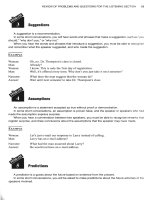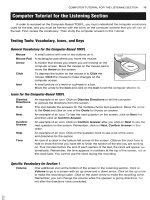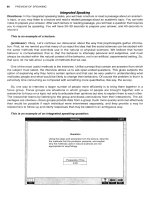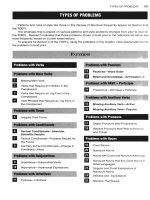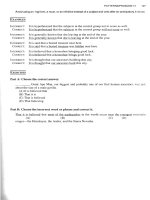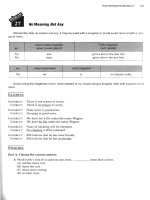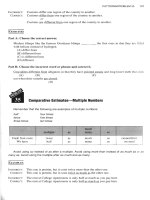Tài liệu How to prepare for the foefl part 40 ppt
Bạn đang xem bản rút gọn của tài liệu. Xem và tải ngay bản đầy đủ của tài liệu tại đây (1.14 MB, 10 trang )
4.
The word
¶!
in paragraph
1
refers to
GD
water
CD
depth
0
pressure
CD
surface
A geyser is the result of underground water
under the combined conditions of high temperatures
and increased pressure beneath the surface of the
Earth. Since temperature rises about
1°F
for every
sixty feet under the Earth's surface, and pressure
increases with depth, water that seeps down in
cracks and fissures until it reaches very hot rocks
in the Earth's interior becomes heated to a
temperature of approximately
290°F.
Water under pressure can remain liquid at
temperatures above its normal boiling point, but in
a geyser, the weight of the water nearer the
surface exerts so much pressure on the deeper
water that the water at the bottom of the geyser
reaches much higher temperatures than does the
water at the top of the geyser. As the deep water
becomes hotter, and consequently lighter, it
suddenly rises to the surface and shoots out of the
surface in the form of steam and hot water. In
turn, the explosion agitates all the water in the
geyser reservoir, creating further explosions.
Immediately afterward, the water again flows into
the underground reservoir, heating begins, and
the process repeats itself.
5.
Click on the paragraph that explains the role
of water pressure in an active geyser.
Scroll the passage to see all of the para-
graphs.
6.
As depth increases
@
pressure increases but temperature does
not
CD
temperature increases but pressure does
not
O
both pressure and temperature increase
CD
neither pressure nor temperature
increases
7.
Why does the author mention New Zealand
and Iceland in paragraph
4?
@
To compare areas of high volcanic
activity
CD
To describe the Yellowstone National
Park
O
To provide examples of areas where
geysers are located
a
To name the two regions where all
geysers are found
Paragraph
4
is marked with an arrow
(-+).
Immediately afterward, the water again flows into
the underground reservoir, heattng begins, and
the process repeats itself.
In order to function, then,
a
geyser must have
a source of heat, a reservoir where water can be
stored until the temperature rises to an unstable
point, an opening through which the hot water and
steam can escape, and underground channels for
resupplying water after an eruption.
-+
Favorable conditions for geysers exist in
regions of geologically recent volcanic activity,
especially in areas of more than average
precipitation. For the most part, geysers are
located in three regions of the world: New
Zealand, Iceland, and the Yellowstone National
Park area of the United States. The most famous
geyser in the world is Old Faithful in Yellowstone
Park. Old Faithful erupts every hour, rising to a
height of
125
to
170
feet and expelling more than
ten thousand gallons during each eruption. Old
Faithful earned its name because, unlike most
geysers, it has never failed to erupt on schedule
even once in eighty years of observation.
392
TOEFL MODEL TESTS
8.
How often does Old Faithful erupt?
GD
Every
10
minutes
GD
Every
60
minutes
O
Every
125
minutes
CD
Every
170
minutes
9.
The word
mi
in paragraph
4
is
closest in meaning to
GD
heating
CD
discharging
O
supplying
CD
wasting
Immediately afterward, the water again flows into
the underground reservoir, heating begins, and
the process repeats itself.
In order to function, then, a geyser must have
a source of heat, a reservoir where water can be
stored until the temperature rises to an unstable
point, an opening through which the hot water and
steam can escape, and underground channels for
resupplying water after an eruption.
Favorable conditions for geysers exist in
regions of geologically recent volcanic activity,
especially in areas of more than average
precipitation. For the most part, geysers are
located in three regions of the world: New
Zealand, Iceland, and the Yellowstone National
Park area
of the United States. The most famous
geyser in the world is Old Faithful in Yellowstone
Park. Old Faithful erupts every hour, rising to
a
height of
125
to 170 feet and
eFp61li"ng
more than
ten thousand gallons during each eruption. Old
Faithful earned its name because, unlike most
geysers, it has never failed to erupt on schedule
even once in eighty years of observation.
10.
What does the author mean by the statement
OldPa"lfifiTeamEfifi~n~mTbr~ca~e,
unlike most geysers,
it
has never failedT6
erupt on schedule even once
in
eishty
pea?<
of observation
?
GD
Old Faithful always erupts on schedule.
GD
Old Faithful is usually predictable.
O
Old Faithful erupts predictably like
other geysers.
CD
Old Faithful received its name because
it has been observed for many years.
11.
According to the passage, what
is
required
for a geyser to function?
CD
A
source of heat, a place for water to
collect, an opening, and underground
channels
CD
An
active volcano nearby and
a
water
reservoir
O
Channels in the Earth and heavy rainfall
CD
Volcanic activity, underground chan-
nels, and steam
MODEL
TEST
6
393
This question has often been posed: Why
were the Wright brothers able to succeed in an
(
effort at which so many others had failed? Many
explanations have been mentioned, but three
reasons are most often cited. First, they were a
(
team. Both men worked congenially and
cooperatively, read the same books, located and
shared information, talked incessantly about the
(
possibility of manned flight, and sewed as a
cons~stent source of inspiration and encouragement
to each other. Quite simply, two geniuses are
(
better than one.
Both were glider pilots. Unlike some other
engineers who experimented with the theories of
1
flight, Owille and Wilbur Wright experienced the
practical aspects of aerodynamics by building and
flying in kites and gliders. Each craft they built was
1
slightly superior to the last, as they incorporated
knowledge that they had gained from previous
failures. They had realized from their experiments
I
that the most serious challenge in manned flight
would be stabilizing and maneuvering the aircraft
once it was airborne. While others concentrated
their efforts on the problem of achievilig lift for
take-off, the Wright brothers were focusing on
developing a three-axis control for guiding their
I
aircraft. By the time that the brothers started to
build an airplane, they were already among the
world's best glider pilots; they knew the problems
of riding the air first hand.
In addition, the Wright brothers had designed
more effective wings for the airplane than had
been previously engineered. Using a wind tunnel,
they tested more than two hundred different wing
designs, recording the effects of slight variations
in shape on the pressure of air on the wings. The
data from these experiments allowed the Wright
brothers to construct a superior wing for their
arrcraft.
In spite of these advantages, however, the
Wright brothers might not have succeeded had
they not been born at precisely the opportune
moment in history. Attempts to achieve manned
flight in the early nineteenth century were doomed
because the steam engines that powered the
aircrafts were too heavy in proportion to the power
that they produced. But by the end of the
nineteenth century, when the brothers were
experimenting with engineering options, a
relatively light internal combustion engine had
already been invented, and they were able to
bring the ratio of weight to power within
acceptable limits for flight.
1
12.
Which of the following is the main topic of
the passage?
The reasons why the Wright brothers
succeeded in manned flight
GD
The advantage of the internal combus-
tion engine in the Wright brothers'
experiments
O
The
Wright brothers' experience as
pilots
CD
The importance of gliders to the devel-
opment of airplanes
13.
The word
FffB
in paragraph
1
is closest in
meaning to which of
the
following?
a
disregarded
mentioned
O
considered
CD
proven
This question has often been posed:
Why
were the Wright brothers able to succeed in an
effort at which so many others had failed? Many
explanations have been mentioned, but three
reasons are most often cited. First, they were a
team. Both men worked congenially and
cooperatively, read the same books, located and
shared information, talked incessantly about the
possibility of manned flight, and served as a
consistent source of inspiration and encouragement
to each other. Quite simply, two geniuses are
better than one.
Both were glider pilots. Unlike some other
engineers who experimented with the theories of
flight, Orville and Wilbur Wright experienced the
practical aspects of aerodynamics by building and
flying in kites and gliders. Each craft they built was
slightly superior to the last, as they incorporated
knowledge that they had gained from previous
failures. They had realized from their experiments
that the most serious challenge in manned flight
would be stabilizing and maneuvering the aircraft
once it was airborne. While others concentrated
their efforts on the problem of achieving lift for
394
TOEFL MODEL
TESTS
14.
The word
m?y
in paragraph
1
could
best be replaced by which of the following?
confidently
CD intelligently
O
constantly
CCD
optimistically
This question has often been posed: Why
were the Wright brothers able to succeed in an
effort at which so many others had failed? Many
explanations have been mentioned, but three
'i'
reasons are most often cited. First, they were a
team. Both men worked congenially and
cooperatively, read the same books, located and
shared information, talked incessani about the
possibility of manned flight, and sewed as a
.#
>.
consistent source of inspiration and encouragement
-%
to each other. Quite simply,
two
geniuses are
better than one.
I.
Both were glider pilots. Unlike some other
-<
engineers who experimented w~th the theories of
'i
flight, Orville and Wilbur Wright experienced the
I
,
practical aspects
of
aerodynamics by building and
,.
flying in kites and gliders. Each crafi they built was
,q
.'I
slightly superior to the last, as they incorporated
knowledge that they had gained from previous
failures. They had realized from their experiments
7
that the most serious challenge in manned flight
LC
would be stabilizing and maneuvering the aircraft
once it was airborne. While others concentrated
,
their efforts on the problem of achieving lift for
T
15.
What kind of experience did the Wright
brothers have that distinguished them from
their competitors?
@
They were geniuses.
CD
They were glider pilots.
O
They were engineers.
a
They were inventors.
16.
Click on the sentence in paragraph
2
that
explains the most serious problem that the
Wright brothers anticipated in constructing a
manned aircraft.
Paragraph
2
is marked with an arrow
(4).
consistent source of insp~raton and encouragement
to each other. Quite simply, two geniuses are
better than one.
-+
Both were glider pilots. Unlike some other
engineers who experimented with the theories of
flight, Orville and Wilbur Wright experienced the
practical aspects of aerodynamics by building and
flying in kites and gliders. Each craft they built was
I
slightly superior to the last, as they incorporated
knowledge that they had gained from previous
failures. They had realized from their experiments
I
that the most serious challenge in manned flight
would be stabilizing and maneuvering the aircraft
once it was airborne. While others concentrated
their efforts on the problem of achieving lift for
take-off, the Wright brothers were focuslng on
developing a three-axis control for guiding their
aircraft. By the time that the brothers started to
build an airplane, they were already among the
world's best glider pilots; they knew the problems
of riding the air first hand.
In addition, the Wright brothers had designed
more effective wings for the airplane than had
been previously eng~neered. Using a wind tunnel,
17.
Look at the word "in"aiEEFfinz in the
passage. Click on the word or phrase in the
bold text that is closest in meaning to
Rani.
Both were glider pilots. Unl~ke some other
engineers who experimented wlth the theories of
flight, Orville and Wilbur Wright experienced the
practical aspects of aerodynamics by building and
flying in kites and gliders. Each craft they built was
slightly superior to the last, as they incorporated
knowledge that they had gained from previous
failures. They had realized from their experiments
that the most serious challenge in manned flight
would be stabilizing and maneuveting the aircraft
once
it
was airborne. While others concentrated
their efforts on the problem of achieving
lift
for
take-off, the Wright brothers were focusing on
developing a three-axis control for guiding their
aircraft. By the time that the brothers started to
build an airplane, they were already among the
world's best glider pilots; they knew the problems
of riding the air first hand.
In addition, the Wright brothers had designed
more effective wings for the airplane than had
been previously engineered. Uslng a w~nd tunnel,
they tested more than two hundred different wing
designs, recording the effects of slight variations
in shape on the pressure of air on the winqs. The
18.
Why does the author suggest that the experi-
ments with the wind tunnel were important?
GD
Because they allowed the Wright broth-
ers to decrease the weight of their air-
plane to acceptable limits
GD
Because they resulted in a three-axis
control for their airplane
O
Because they were important in the re-
finement of the wings for their airplane
a
Because they used the data to improve
the engine for their airplane
19.
The word in paragraph
3
refers to
GD
the Wright brothers
@
aircraft
O
engines
QD
attempts
-
more effectwe wlngs for the a~rplane than had
been
previously
eng~neered Uslng a wind tunnel,
they tested more than two hundred d~fferent wlng
designs, recordtng the effects of si~ght varlat~ons
In shape on the pressure of alr on the wlngs The
data from these
experiments
allowed the Wrlght
brothers to construct a supertor wlnq for thew
-
aircraft.
In spite of these advantages, however, the
Wright brothers might not have succeeded had
they not been born at precisely the opportune
moment in history. Attempts to achieve manned
flight in the early nineteenth century were doomed
because the steam engines that powered the
aircrafts were too heavy in proportion to the power
that they produced. But by the end of the
nineteenth century, when the brothers were
experimenting with engineering options, a
relatively light internal combustion engine had
already been invented, and they were able to
bring the ratio of weight to power within
acceptable limits for flight.
20.
The word
,ToTrIiZi
in paragraph
4
is closest
in meaning to
destined to fail
@
difficult
to
achieve
O
taking a risk
CD
not well planned
more effective wings for the airplane than had
been previously engineered. Using a wind tunnel,
they tested more than two hundred different wing
designs, recording the effects of slight variations
in shape on the pressure of air on the wings. The
data from these experiments allowed the Wright
brothers to construct a superior wing for their
aircraft.
In spite of these advantages, however, the
Wright brothers might not have succeeded had
they not been born at precisely the opportune
moment in history. Attempts
to
achieve manned
flight in the early nineteenth century were doomed
because the steam engines that powered the
aircrafts were too heavy in proportion to the power
that they produced. But by the end of the
nineteenth century, when the brothers were
experimenting with engineerlng options, a
relatively light internal combustion engine had
already been invented, and they were able to
bring the ratio of weight to power within
acceptable limits for flight.
396
TOEFL
MODEL
TESTS
2
1.
In paragraph
4,
the author suggests that the
steam engines used
in
earlier aircraft
had failed because
GO
They were too small to power a large
plane.
a
They were too light to generate enough
power.
O
They did not have internal combustion
power.
CD
They did not have enough power to lift
their own weight.
Paragraph
4
is marked with an arrow
(+).
more effective wings for the airplane than had
been previously engineered. Using a w~nd tunnel,
they tested more than two hundred different wing
designs, recording the effects of slight variations
in shape on the pressure of air on the wings. The
data from these experiments allowed the Wright
brothers to construct a superior wing for their
aircraft.
+
In spite of these advantages, however, the
Wright brothers might not have succeeded had
they not been born at precisely the opportune
moment in history. Attempts to achieve manned
flight in the early nineteenth century were doomed
because the steam engines that powered the
aircrafts were too heavy in proportion to the power
that they produced. But by the end of the
nineteenth century, when the brothers were
experimenting with engineering options, a
relatively light internal combustion engine had
already been invented, and they were able to
bring the ratio of weight to power within
acceptable limits for flight.
22.
The passage discusses all of
the
following
reasons that the Wright brothers succeeded
EXCEPT
They worked very well together.
CD
They both had practical experience
building other aircraft.
O
They made extensive tests before they
completed the design.
CD
They were well t'unded.
The influenza virus is a single molecule composed
of millions of individual atoms. Although bacteria can
be
considered a type of plant, secreting poisonous
substances into the body of the organism they attack,
viruses, like the influenza virus, are living organisms
themselves. We may consider them regular chemical
molecules since they have strictly defined atomic
structure; but on the other hand, we must also consider
them as being alive since they are able to muitiply in
unlimited quantities.
An attack brought on by the presence of the
influenza virus in the body produces a temporary
immunity, but, unfortunately, the protection is against
only the type
of
virus that caused the influenza.
Because the disease can be produced by any one
of three types, referred to as
A,
6,
or
C,
and many
varieties within each type, immunity to one virus will not
prevent infection by other types or strains. Protection
from the influenza virus is also complicated by the fact
that immunity to a specific virus persists for less than
a year. Finally, because a virus may periodically
change characteristics,'the problem of mutation makes
it difficult to carry out a successful immunization
program. Vaccines are often ineffective against newly
evolving strains.
Approximately every ten years, worldwide
epidemics of influenza called pandemics occur.
Thought to be caused by new strains of type-A virus,
these pandemic viruses have spread rapidly, infecting
millions of people.
Vaccines have been developed that have been
found to be
70
to
90
percent effective for at least six
months against either
A
or
B
types of the influenza
virus, and a genetically engineered live-virus vaccine
is under development. Currently, the United States
Public Health Service recommends annual vaccination
only for those at greatest risk of complications from
influenza, including pregnant women and the elderly.
Nevertheless, many other members of the general
population request and receive flu shots every year,
and even more are immunized during epidem~c or
pandemic cycles.
MODEL
TEST
6
397
23.
Which of the following is the main topic of
the passage?
CD
The influenza virus
CD
Immunity to disease
O
Bacteria
CD
Chemical molecules
24.
According to this passage, bacteria are
CD
poisons
CE9
very small
O
larger than viruses
CD
plants
25.
Look at the word
wFBE8RT
in the passage.
Click on the word or phrase in the
bold
text
that refers to.
The influenza virus is a single molecule
composed of millions of individual'atoms. Although
bacteria can
be
considered a
type
of plant, secreting
poisonous substances into the body of the organism
they attack,.viruses, like the influenza virus, are living
organisms themselves. We may consider them regular
chemical molecules since they have strictly defined
atomic structure; but on the other hand, we must also
consider them as being alive since they are able to
multiply in unlimited quantities.
An attack brought on by the presence of the
influenza virus in the body produces a temporary
immunity, but, unfortunately, the protection is against
only the type of virus that caused the influenza.
Because the disease can be produced by any one of
three types, referred to as
A,
B,
or
C,
and many
varieties within each type, immunity to one virus will
not prevent infection by other types or strains.
Protection from the influenza virus is also complicated
by the fact that immunity to a specific virus persists for
less than a year. Finally, because a virus may
periodically change characteristics, the problem of
mutation makes it difficult to carry out a successful
immunization program. Vaccines are often ineffective
26.
The word
in paragraph
1
could best
be replaced by
@
unusually
CD
completely
O
broadly
a
exactly
The influenza virus is a single molecule
composed of millions of individual atoms. Although
bacteria can be considered a type of plant, secreting
poisonous substances into the body of the organism
they attack, viruses, like the influenza virus, are living
organisms themselves. We may considerthem regular
chemical molecules since they have strictly defined
atomic structure; but on the other hand, we must also
consider them as being alive since they are able to
multiply in unlimited quantities.
An attack brought on by the presence of the
influenza virus in the body produces a temporary
immunity, but, unfortunately, the protection is against
only the type of virus that caused the influenza.
Because the disease can be produced by any one of
three types, referred to as A,
B,
or
C,
and many
varieties within each type, immunity to one virus will
not prevent infection by other types or strains.
Protection from the influenza virus is also complicated
by the fact that immunity to a specific virus persists for
less than a year. Finally, because a virus may
periodically change characteristics, the problem of
mutation makes it difficult to carry out
a
successful
immunization program. Vaccines are often ineffective
27.
The atomic structure of viruses
is variable
CE9
is strictly defined
O
cannot be analyzed chemically
CD
is more complex than that of bacteria
28.
Why
does the author say that viruses are
alive?
GD
They have a complex atomic structure.
a
They move.
O
They multiply.
a
They need warmth and light.
398
TOEFL
MODEL
TESTS
29.
The word
IiITiREd
in paragraph
1
could
best be replaced by which of the following?
GD
very small
CD
very large
O
very similar
CD
very different
poisonous substances into the body of the organism
they attack, viruses, like the influenza virus, are living
organism's themselves. We may consider them regular
chemical molecules since they have strictly defined
atomic structure; but on the other hand, we must also
consider them as being alive since they are able to
multiply in unlimited quantities.
An attack brought on by the presence of the
influenza virus in the body produces a temporary
immunity, but, unfortunately, the protection is against
only the type of virus that caused the influenza.
Because the disease can be produced by any one of
three types, referred to as A, B, or C, and many
varieties within each type, immunity to one virus will
not prevent infection by other types or strains.
Protection from the influenza virus is also complicated
by the fact that immunity to a specific virus persists for
less than
a
year. Finally, because a virus may
periodically change characteristics, the problem of
mutation makes it difficult to carry out a successful
immunization program. Vaccines are often ineffective
against newly evolving strains.
Approximately every ten years, worldwide
e~idemics of influenza called pandemics occur.
30.
Look at the word
;?lTi%S
in the passage.
Click on another word or phrase in the
bold
text that is closest in meaning to
only the type of virus that caused the influenza.
Because the disease can be produced by any one of
three types, referred to as A,
B,
or
C,
and many
varieties within each type, immunity to one virus will
not prevent infection
by
other types or strains.
Protection from the influenza virus is also complicated
by
the
fact that immunity to a specific virus
persists
for
less than a year. Finally, because a virus may
periodically change characteristics, the problem of
mutation makes it difficult to carry out a successful
immunization
program. Vaccines are often ineffective
against newly evolving strains.
Approximately every ten years, worldwide
epidemics of influenza called pandemics occur.
Thought to be caused by new strains of type-A virus,
these pandemic viruses have spread rapidly, infecting
millions of people.
Vaccines have been devetoped that have been
found to be
70
to
90
percent effective for at least six
months against either A or B types of the influenza
virus, and
a
genetically engineered live-virus vaccine
is under development. Currently, the United States
Public Health Service recommends annual vaccination
only for those at greatest risk of complications from
3
1.
The following sentence can be added to the
passage.
Epidemics or regional outbreaks have
appeared on the average every two or
three years for type-A virus, and
every four or five years for type-B
virus.
Where would it best fit into the passage?
Click on the square
(M)
to add the sentence
to the passage.
Scroll the passage to see all of the choices.
5
E
[
mutatlon makes ~t dlfflcult to carry out a successful
immunization program ~accines.are often ineffective
against newly evolving strains.
. Approximately every ten years, worldwide
epidemics of influenza called pandemics occur.
Thought to be caused by new strains of type-A virus,
these pandemic viruses have spread rapidly, infecting
millions of people.
Vaccines have been developed that have been
found to be
70
to
90
percent effective for at least six
months against either
A
or
B
types of the influenza
virus, and a genetically engineered live-virus vaccine
is under develo~ment. WCurrentlv, the United States
Public Health Service recommends annual vaccination
only for those at greatest risk of complications from
influenza, including pregnant women and the elderly.
Nevertheless, many other members of the general
population request and receive flu shots every year,
and even more are immunized during epidemic or
pandemic cycles
32.
According to the passage, how does the
body react to the influenza virus?
GD
It prevents further infection to other
types and strains of the virus.
CD
It produces immunity to the type and
strain of virus that invaded it.
O
It becomes immune to types A,
B,
and
C viruses, but not to various strains
within the types.
CD
After a temporary immunity, it becomes
even more susceptible to the type and
strain that caused the influenza.
33.
The passage discusses all of the following
as characteristics of pandemics
EXCEPT
GD
they spread very quickly
they are caused
by
type-A
virus
O
they are regional outbreaks
a
they occur once every ten years
The Federal Reserve System, as an
independent agency of the United States
government, is charged with overseeing the
national banking system. Since
1913
the Federal
Reserve System, commonly called the Fed, has
served as the central bank for the United States.
The system consists of twelve District Reserve
Banks and their branch offices, along with several
committees and councils. All national commercial
banks are required by law to be members of the
Fed, and all deposit-taking institutions like credit
unions are subject to regulation by the Fed
regarding the amount of deposited funds that must
be held in reserve and that by definition, therefore,
are not available for loans. The most powerful
body is the seven-member Board of Governors in
Washington, appointed by the President and
confirmed by the Senate.
The System's primary function is to control
monetary policy by influencing the cost and
availability of money and credit through the
purchase and sale of govemment securities. If the
Federal Reserve provides too little money, interest
rates tend to be high, borrowing is expensive,
business activity slows down, unemployment goes
up, and danger of recession is augmented. If there
is too much money, interest rates decline, and
borrowing can lead to excess demand, pushing up
prices and fuel~ng inflation.
The Fed has several responsibilities in addition
to controlling the money supply. In collaboration
with the U.S. Department of the Treasury, the Fed
puts new coins and paper currency into circulation
by issuing them to banks. It also supervises the
activities of member banks abroad, and regulates
certain aspects of international finance.
It has been said that the Federal Reserve is
actually a fourth branch of the United States
government because it is composed of national
policy makers. However, in practice, the Federal
Reserve does not stray from the financial policies
established by the executive branch of the
govemment. Although it is true that the Fed does
not depend on Congress for budget allocations,
and therefore is free from the partisan politics that
influence most of the other governmental bodies,
it is still responsible for frequent reports to the
Congress on the conduct of monetary policies.
400
TOEFL MODEL TESTS
34.
Which of the following is the most appropri-
ate title for the passage?
GD
Banking
a
The Federal Reserve System
O
The Board of Governors
Monetary Policies
35.
The word
in
paragraph
1
is clos-
est in'meaning to
C9
supervising
maintaining
O
financing
stimulating
The Federal Rese~e System, as an
independent agency of the United States
government, is charged with overseeing the
national banking system. Since
191
3
the Federal
Reserve System, commonly called the Fed, has
served as the central bank for the United States.
The system consists of twelve District Reserve
Banks and their branch offices, along with several
committees and councils. All national commercial
banks are required by law to be members of the
Fed, and all deposit-taking institutions like credit
unions are subject to regulation by the
Fed
regarding the amount of deposited funds that must
be held in reserve and that by definition, therefore,
are not available for loans. The most powerful
body is the seven-member Board of Governors in
Washington, appointed by the President and
confirmed
by
the Senate.
The System's primary function is to control
monetary policy by influencing the cost and
availability of money and credit through the
purchase and sale of government securities. If the
Federal Reserve provides too little money, interest
rates tend to be high, borrowing is expensive,
36.
The word
l%lR%ET
in paragraph
1
could
best be replaced by
GD
modified
CD
considered
O
examined
CD
approved
The Federal Reserve System, as an
independent agency of the United States
government, is charged with overseeing the
national banking system. Since
191
3
the Federal
Reserve System, commonly called the Fed, has
sewed as the central bank for the United States.
The system consists of twelve District Reserve
Banks and their branch offices, along with several
committees and councils. All national commercial
banks are required by law to be members of the
Fed, and all deposit-taking institutions like credit
unions are subject to regulation by the Fed
regarding the amount of deposited funds that must
be held in reserve and that by definition, therefore,
are not available for loans. The most poweFful
body is the seven-member Board of Governors in
Washington, appointed by the President and
I
conmed by the Senate.
The System's primary function is to control
monetary policy by influencing the cost and
availability of money and credit through the
purchase and sale of government securities. If the
Federal Reserve provides too little money, interest
rates tend to be high, borrowing is expensive,
37.
According to
the
passage, the principal
responsibility of the Federal Reserve
System is
GD
to borrow money
to regulate monetary policies
O
to print government securities
CD
to appoint the Board of Governors
